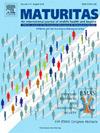围绝经期和绝经后早期女性的运动和大脑健康:范围综述
IF 3.6
2区 医学
Q2 GERIATRICS & GERONTOLOGY
引用次数: 0
摘要
更年期过渡与卵巢激素水平的剧烈波动和最终下降有关,导致神经保护功能丧失,标志着这是促进女性大脑健康的重要干预期。体育活动和锻炼可以改善老年、绝经后女性的大脑健康。运动(体力活动和锻炼)是否能保护围绝经期和绝经后早期女性的大脑健康尚不清楚。本综述的目的是绘制研究围绝经期和绝经后早期女性运动与大脑健康之间关系的文献图谱,重点是确定关键的方法学方法和知识空白。纳入标准:本范围综述考虑了任何设计的研究,包括运动成分,主要关注围绝经期女性,次要关注绝经后早期女性,以及脑健康结果。方法本综述遵循JBI的建议和方法以及PRISMA-ScR报告指南。检索了以下数据库:Medline All (OVID)、Embase (OVID)、APA PsycInfo (OVID)、Scopus (Elsevier)、CINAHL (Ebsco)和SportDiscus (Ebsco)。提取了有关参与者人群、研究方法和主要发现的详细信息。结果在30,927份已确认的记录中,有19项研究被纳入综合研究,其中3项研究仅针对围绝经期女性,8项研究仅针对早期绝经后女性,8项研究采用混合队列。有氧训练是最常见的运动形式(n = 7),执行功能是最常见的脑健康结果(n = 12)。13项研究(68.4%)发现运动对大脑健康有益。结论:在本综述中,我们涵盖了迄今为止发表的有限的研究,这些研究探讨了围绝经期和绝经后早期女性的运动和大脑健康。虽然目前的研究为运动和体育活动在这一时期促进大脑健康的有效性提供了有希望的支持,但需要更多高质量的围绝经期研究,包括标准化的生殖分期和全面的大脑健康和更年期症状测量,以确定在这一关键的神经衰老时期运动的有效性。协议注册doi: 10.17605/OSF.IO/F52JR本文章由计算机程序翻译,如有差异,请以英文原文为准。
Movement and brain health in perimenopausal and early postmenopausal females: A scoping review
Introduction
The menopause transition is associated with dramatic fluctuations and eventual decline in levels of ovarian hormones, leading to loss of neuroprotection, marking this as an important intervention period for brain health promotion in females. Physical activity and exercise can improve brain health in older, postmenopausal females. Whether movement (physical activity and exercise) can protect brain health in perimenopausal and early postmenopausal females is not clear.
Objective
The objective of this scoping review was to map the literature examining the relationship between movement and brain health in perimenopausal and early postmenopausal females, with a focus on identifying key methodological approaches and gaps in the knowledge.
Inclusion criteria
This scoping review considered studies of any design that included a movement component with a primary focus on perimenopausal females and secondary focus on early postmenopausal females, with a brain health outcome.
Methods
This scoping review followed JBI recommendations and methodology and the PRISMA-ScR reporting guidelines. The following databases were searched: Medline All (OVID), Embase (OVID), APA PsycInfo (OVID), Scopus (Elsevier), CINAHL (Ebsco), and SportDiscus (Ebsco). Details about participant population, study methods, and key findings were extracted.
Results
Of the 30,927 identified records, 19 studies were included in the synthesis, with 3 studies conducted with only perimenopausal females, 8 studies with only early postmenopausal females, and 8 studies with a mixed cohort. Aerobic training was the most common form of movement (n = 7) and executive function was the most common brain health outcome measured (n = 12). Benefits of movement on brain health were seen in 13 studies (68.4%).
Conclusion
In this scoping review, we cover the limited research published to date that explores movement and brain health in perimenopausal and early postmenopausal females. While current research provides promising support for the effectiveness of exercise and physical activity to promote brain health during this period of the lifespan, more high-quality studies in perimenopause are needed with standardized reproductive staging and comprehensive brain health and menopausal symptom measures to establish the effectiveness of exercise during this critical neuro-aging period.
Protocol registration
doi: 10.17605/OSF.IO/F52JR
求助全文
通过发布文献求助,成功后即可免费获取论文全文。
去求助
来源期刊

Maturitas
医学-妇产科学
CiteScore
9.10
自引率
2.00%
发文量
142
审稿时长
40 days
期刊介绍:
Maturitas is an international multidisciplinary peer reviewed scientific journal of midlife health and beyond publishing original research, reviews, consensus statements and guidelines, and mini-reviews. The journal provides a forum for all aspects of postreproductive health in both genders ranging from basic science to health and social care.
Topic areas include:• Aging• Alternative and Complementary medicines• Arthritis and Bone Health• Cancer• Cardiovascular Health• Cognitive and Physical Functioning• Epidemiology, health and social care• Gynecology/ Reproductive Endocrinology• Nutrition/ Obesity Diabetes/ Metabolic Syndrome• Menopause, Ovarian Aging• Mental Health• Pharmacology• Sexuality• Quality of Life
 求助内容:
求助内容: 应助结果提醒方式:
应助结果提醒方式:


